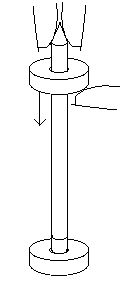The title says it all
The title says it all
Introduction
Magnets exert strong forces on other magnets over large distances.

Collision in one-dimension
Materials
A pencil with a steel eraser holder.(Check that magnets will attract the metal band around the eraser. If you cannot find a pencil with a steel eraser band you can follow the instructions below to make a useable pencil.
Two donut magnets which will fit onto the pencil. (Available from Radio Shack. Also from project RAFT.)
To do and notice
Slide one magnet onto the pencil until it sticks
to the steel eraser holder.
Hold the pencil vertical with the point up.
Place a second magnet on the point of the pencil and drop it onto the
first.
Hold onto the pencil!
If the magnets repel each other the falling magnet will stop while
the bottom magnet will pop off the bottom of the pencil.
To the eye it appears as if the falling magnet passes right through
the stationary magnet.
If the falling magnet is attracted to the bottom magnet, both will
pop off the bottom of the pencil.
What’s Going On?
When a moving object collides with a stationary
object of the same mass. The moving object can come to rest
transferring all of its energy to the object initially at rest. The
object which was at rest goes off at the same speed the moving object
had before the collision.
Magnets can do this via a magnetic interaction, the two objects do
not have to physically touch.
When the two magnets attract each other they physically collide and join together. Physicists call this type of collision an inelastic collision. After an inelastic collision of a moving object and a stationary object both objects move off together. The speed at which the two objects move off is less than the speed of the original object.
Etc.
Race two magnet collisions side by side. The elastic collision magnet will beat the inelastic one to the ground. Some of the energy of motion of the first magnet is lost in the inelastic collision.
Try dropping two magnets onto one, elastically, and see what happens.
You can analyze the collision with a helpful frame of reference guide pdf.
Start with a pencil with a nonmagnetic eraser band. Cut off the eraser flush with the top of the magnet.
Drill a 1/16 (1.5 mm) diameter hole into the center of the remaining eraser.
Screw a pan-head wood screw size 8 length 3/8 to1/2 inch into the end of the pencil until the bottom of the pan head is flush with the top of the eraser. The pan head should not stick out beyond the edge of the eraser.
This pencil will now act like a pencil with a steel eraser band.
Return to top.
|
Scientific Explorations with Paul Doherty |
|
23 June 2000 |